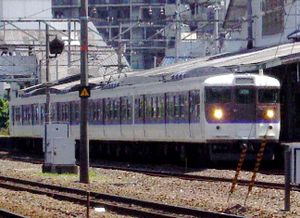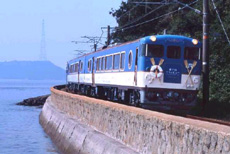Kure Line
From TrainSpottingWorld, for Rail fans everywhere
The Kure Line (呉線 Kuresen?) is a rail line operated by JR West within Hiroshima Prefecture, Japan. It begins at Mihara Station in Mihara and terminates at Kaitaichi Station in Kaita. It's one of the main lines of JR West. The section between Mihara Station to Hiro Station is nicknamed "Setouchi Sazanami Line" (Seto Inland Sea Ripple Line) as the sightseeing line. The section between Mihara Station and Hiro Station, most trains runs from Hiro Station through Mihara Station to Itozaki Station. The section between Hiro Staition and Kaitaich Station, most trains runs from Hiro Station through Kaitaichi Station to Hiroshima Station or Iwakuni Station.
Contents
Line data
- Operator: West Japan Railway Company (Class-1 railroad)
- Official line length: 87.0km
- Gauge: 1067mm
- Stations: 28 (including Mihara Statio and Kaitaichi Station)
- Double track: none (entirely single track)
- Electrified sections: all (DC 1500V)
- Closure system: Special automatic closure type (track circuit detection)
- Speed limit: 95km/h
- Operational command: Hiroshima Integrated Command Center
Special trains
Akiji liner
- Commuter Liner is nicknamed as "Akiji Liner" (Aki-route Liner).
- The trains runs the section between Hiroshima Station to Kure Station in about 30 minutes.
Setouchi Marine View
- Sightseeing Trains "Setouchi Marine View" (Seto Inland Sea Marine View) are operated since October 1, 2005.
History
Kure Line
- Opened the line between Kaitaichi Station to Kure Station including Yano Station, Saka Station, Tennō Station and Yoshiura Station on December 27, 1903.
- Opened temprary station (Hamasaki Station) on July 28, 1904.
- Rent for Sanyo Rail Way from December 1, 1904.
- Nationalized from December 1, 1906.
- Named "Kure Line" as one of national rail ways on October 12, 1909.
- Opened Koyaura Station and Closed Hamasaki Station on May 1, 1914.
- Opened temprary station (Akihamasaki Station) on July 21, 1926.
- Opened temprary station (Karyugahama Station) on July 7, 1928.
- Extended the line from Kure Station to Hiro Station and opened Akiaga Station and Hiro Station on March 24, 1935.
Sango Line
- Opened Sango Line between Mihara Station to Sunami Station on March 19, 1930.
- Extended the line from Sunami Station to Akisaizaki Station on April 28, 1931.
- Extended the line from Akisaizaki Station to Takehara Station including Tadanoumi Station and Ōnori Station on July 10, 1932.
- Extended the line from Takehara Station to Mitsuuchinoumi Station including Yoshina Station, Akimitsu Station and Kazahaya Station on January 17, 1935.
Integration
- Integrated Sango Line into Kure Line and opened Ato Station, Akikawajiri Station, Nigata Station and Kawaraishi Station on November 24, 1935.
After the integration
- Closed Kawaraishi Station on December 1, 1940.
- Renamed Mitsuuchinoumi Station to Yasuura Station on May 1, 1946.
- Renamed Akimitsu Station to Akitsu Station on December 20, 1949.
- Re-opened Kawaraishi Station on August 1, 1958.
- Closed temprary stations (Karyugahama Station and Akihamasaki Station) on August 1, 1967.
- Electrified the rail way on September 15, 1970.
- Stopped cargo services on December 1, 1986.
- Privatized as JR West on April 1, 1987.
- Opened Kure-Portpier Station on March 19, 1992.
- Opened Akinagahama Station on October 1, 1994.
- Opened Karugahama Station and Mizushiri Station and moved Kawaraishi Station on February 7, 1999.
- Opened Shinhiro Station on March 23, 2002.
Stations of the JR West Kure Line
Mihara - Sunami - Akisaizaki - Tadanoumi - Akinagahama - Ōnori - Takehara - Yoshina - Akitsu - Kazahaya - Yasuura - Ato - Akikawajiri - Nigata - Hiro - Shinhiro - Akiaga - Kure - Kawaraishi - Yoshiura - Karugahama - Tennō - Kure-Portpier - Koyaura - Mizushiri - Saka - Yano - Kaitaichi - Mukainada - Tenjingawa - Hiroshima
| JR West lines | |
| Main | Hokuriku – Kansai – Kisei – San'in – Sanyō – Tōkaidō |
| Local | Ako – Bantan – Fukuchiyama – Fukuen – Gantoku – Geibi – Hakubi – Inbi – Kabe – Kakogawa – Kibi – Kishin – Kisuki - Kure – Ohama – Oito – Onoda – Sakai – Sanko – Tsuyama – Ube – Uno – Wakayama – Yamaguchi |


